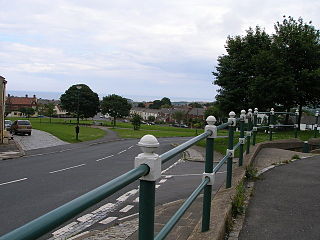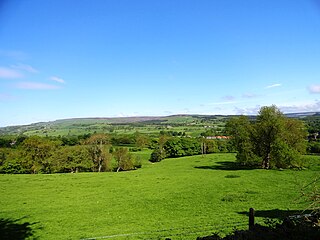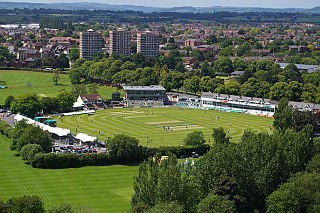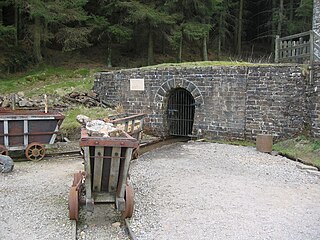
North East England is one of nine official regions of England at the first level of ITL for statistical purposes. The region has three current administrative levels below the region level in the region: combined authority, unitary authority or metropolitan borough, and civil parishes. They are also multiple divisions without administrative functions; ceremonial county, emergency services, built-up areas and historic county. The largest settlements in the region are Newcastle upon Tyne, Middlesbrough, Sunderland, Gateshead, Darlington, Hartlepool and Durham.

Durham is a cathedral city and civil parish in the county of Durham, England. It is the county town and contains the headquarters of Durham County Council, the unitary authority which governs the district of County Durham. It had a population of 48,069 at the 2011 Census.

Chester-le-Street, is a market town on Wearside in the County Durham district, in the ceremonial county of Durham, England, around six miles north of Durham and also close to Sunderland and Newcastle upon Tyne. It is located on the River Wear, which runs out to sea at Sunderland to the east. The town holds markets on Tuesdays, Fridays and Saturdays. In 2011 it had a population of 24,227.

County Durham, officially simply Durham (/ˈdʌrəm/), is a ceremonial county in North East England. The county borders Northumberland and Tyne and Wear to the north, the North Sea to the east, North Yorkshire to the south, and Cumbria to the west. The largest settlement is Darlington, and the county town is the city of Durham.

Easington, also known as Easington Village, is a village and civil parish in eastern County Durham, England. It is located at the junction of the A182 and B1283, leading north-west to Hetton-le-Hole and south east to Horden.

Consett is a town in the County Durham district, in the ceremonial county of Durham, England, about 14 miles (23 km) south-west of Newcastle upon Tyne. It had a population of 27,394 in 2001 and an estimate of 25,812 in 2019.

Worcestershire County Cricket Club is one of eighteen first-class county clubs within the domestic cricket structure of England and Wales. It represents the historic county of Worcestershire. Its Vitality Blast T20 team has been rebranded the Worcestershire Rapids, but the county is known by most fans as 'the Pears'. The club is based at New Road, Worcester. Founded in 1865, Worcestershire held minor status at first and was a prominent member of the early Minor Counties Championship in the 1890s, winning the competition three times. In 1899, the club joined the County Championship and the team was elevated to first-class status. Since then, Worcestershire have played in every top-level domestic cricket competition in England.

Lanehead is a hamlet in the civil parish of Stanhope, in County Durham, England. It lies at the head of Weardale, approximately 2 km west of Cowshill. It is also located near to Killhope, and the boundary of the county of Cumbria. In the 2001 census Lanehead had a population of 40.

Cornriggs is a hamlet in the civil parish of Stanhope, in County Durham, England. It is situated on the north side of Weardale in the North Pennines, which is designated as both an Area of Outstanding Natural Beauty and a UNESCO Global Geopark.

Weardale is a dale, or valley, on the east side of the Pennines in County Durham, England. Large parts of Weardale fall within the North Pennines Area of Outstanding Natural Beauty (AONB) – the second-largest AONB in England and Wales. The upper dale is surrounded by high fells and heather grouse moors. The River Wear flows through Weardale before reaching Bishop Auckland and then Durham, meeting the sea at Sunderland.

Cowshill is a village in the civil parish of Stanhope, in County Durham, England. It is situated at the top of Weardale, between Lanehead and Wearhead. In the 2001 census Cowshill had a population of 156.

Wearhead is a village in the civil parish of Stanhope, in County Durham, England. It is situated at the top of Weardale between Cowshill and Ireshopeburn. It is named after the nearby source of the River Wear which runs eastwards for approx 40 miles (64 km) to Sunderland. In the 2001 census Wearhead had a population of 210.

New Road is a cricket ground in the English city of Worcester. It has been the home ground of Worcestershire County Cricket Club since 1896. Since October 2017 the ground has been known for sponsorship purposes as Blackfinch New Road following a five-year sponsorship arrangement with Blackfinch Investments.

The A689 is a road in northern England that runs east from the A595, 3.1 miles (5.0 km) to the west of Carlisle in Cumbria, to Hartlepool in County Durham.

Diane Maclean is a sculptor and environmental artist, she is a Fellow and council member of the Royal British Society of Sculptors.

The River Wear in Northern England rises in the Pennines and flows eastwards, mostly through County Durham, to the North Sea in the City of Sunderland. At 60 mi (97 km) long, it is one of the region's longest rivers. The Wear wends in a steep valley through the cathedral city of Durham and gives its name to Weardale in its upper reach and Wearside by its mouth.
Old Moss Lead Vein, also known as Killhope Head, is a Site of Special Scientific Interest in the Wear Valley district of County Durham, England. It consists of an exposure of a mineral vein in the valley of the Killhope Burn, just upstream from the North of England Lead Mining Museum.

The North of England Lead Mining Museum, better known as Killhope, is an industrial museum near the village of Cowshill, County Durham, England. The museum stands on the site of the former Park Level Mine, which is being restored to show the workings of a 19th-century lead mine.

Killhope Cross is a mountain pass in the English Pennines. The pass divides Weardale to the east and Cumbria to the west. The road over the pass, the (A689) from Hartlepool to Carlisle, Cumbria, connects the hamlet of Cornriggs in County Durham with the town of Alston, Cumbria. It is the equal highest paved pass in England with the Harthope Moss approximately 10 miles (16 km) to the south, on the other side of Burnhope Seat.
Harthope Moss, also known as Chapel Fell is a mountain pass in the English Pennines. The pass divides Weardale to the north and Teesdale to the south. The unclassified road over the pass connects the A689 at St John's Chapel, County Durham with the B6277 near Langdon Beck in Upper Teesdale, County Durham. It is the equal highest paved pass in England with the Killhope Cross on the A689, approximately 10 miles to the north on the other side of Burnhope Seat.

















